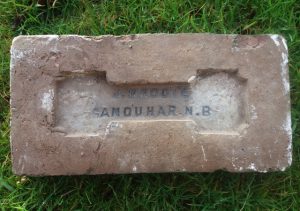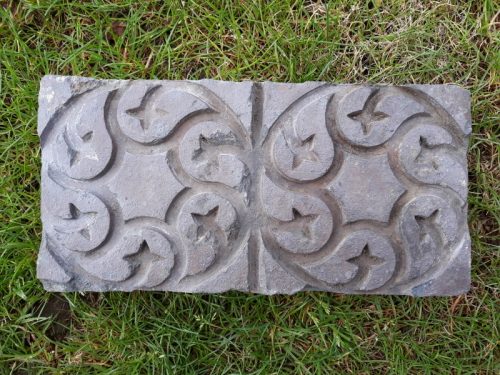Edward VII Coronation June 1902
— 10/01/2024Found by Ginger Benn at an unknown location in England. Edward VII Coronation June 1902. This paver will have been manufactured at an unidentified brickworks in England. . . . .

Found Sanquhar.
Brodie paver – Geometric design – J Brodie Sanquhar NB.
Sanquhar Brick and Tile Works, Sanquhar, Dumfriesshire.
.
.
.

.

Below – This is the exact same geometric design although it is deeper and crisper than the example above. The frog to the rear is identical but it is not stamped. It was found at Wanlockhead in 1974 and has been kindly donated by Nick Basden.


Information – Dumfries Museum …
This pavement tile was made at James Brodie’s brick and tile works in Sanquhar, Dumfriesshire. It has a geometric surface pattern comprising two wheels of raised clay with indents designed to channel water away from the centre of the tile. A ‘blue’ version coloured with the iron oxide found in local carboniferous coal measures has also survived in Dumfriesshire Museum’s collections.
Paving tiles were a niche area of production of the Scottish brick-making industry which, according to Bremner’s, The Industries of Scotland, employed in excess of 4000 people across 122 manufactories in the late 1860s. Sanquhar’s potteries developed from its coal-mining industry, which was founded in 1792 when the Duke of Queensbury began to exploit the coalfields on his estate. The red marls and clays that lay on the upper part of the shallow coal measures to the north of Sanquhar provided a ready source of natural materials for brickmaking, and the character of Sanquhar’s clay made it particularly suitable for making the hardest and most durable type of brick. Trends in agriculture from mid-century set a demand for specialist drainage bricks that became a key area of the industry, including at Sanquhar where Brodie’s brick and tile manufactory had opened in 1852 under the management of George Cleunel.
Bricks and tiles were made by forming clay into wooden moulds shaped to include indentations (‘frogs’) to economise on clay, or by impressing patterns into the surface of pre-moulded bricks. Pressed bricks had increased density that made them heavier and more enduring. When pressed with a raised pattern they provided a decorative and functional surface. Various steam-driven machinery was introduced to streamline the brickmaking process from the 1810s but even large manufactories were dependent on men to oversee the pressing technologies. In 1901 there were 90 men listed in Sanquhar as specialist brickmakers (‘Dumfriesshire’ Cambridge County Geography, 1912).
James Brodie became tenant of the works in 1889 and extended its capabilities to include five Newcastle (barrel-shaped) kilns and a Staffordshire Oven, both particularly suitable for firing outdoor bricks and tiles. The functional nature of Brodie’s tiles made them products suited to the landscape of industrial Scotland. An entry in the 1903 Glasgow Post Office Directory describes the business as ‘Brodie, Jas. Ltd, Sanquhar, supplier off red terra-cotta and blue metallic bricks and tiles’, and notes that Brodie sold his goods through an agent, ‘John Ferguson, at 150 Sinclair Drive, Langside, Glasgow’. Terracotta was much used in architectural works from the mid-nineteenth century. Another Scottish firm, Messrs Alexander Wilson & Son of Dunfermline, supplied much of the terracotta used in the construction of buildings at South Kensington in London in the 1860s.
Decorative pavement tiles shed surface water quickly so were a practical choice for external areas such as stables and canal paths where surface grip was essential. Paving tiles with simple raised grids and diamonds have also been attributed to the Sanquhar works whilst it was under the management of Brodie.